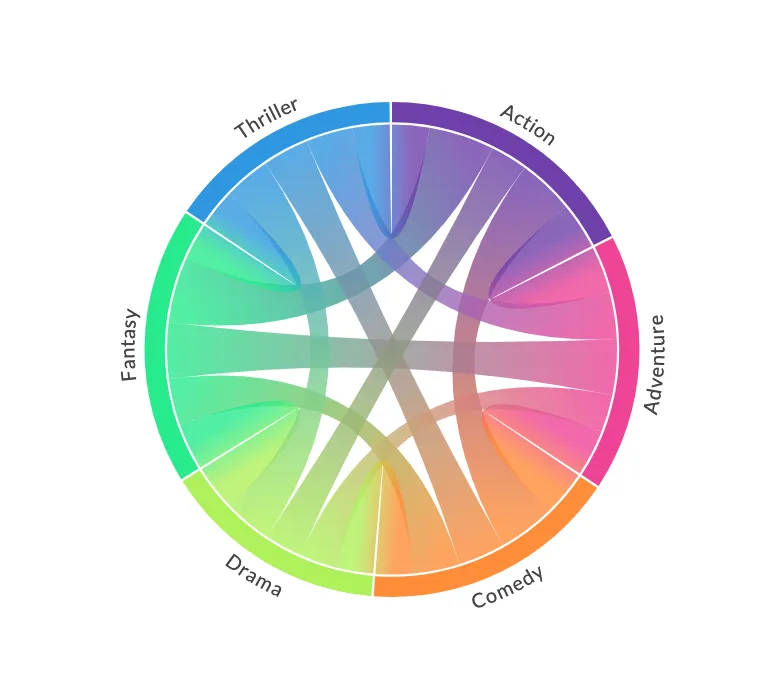Preamble
:sccache 1
:dep plotapi = {Version = "0.1.0"}
use plotapi::params;
use plotapi::Visualisation;
Introduction
In a chord diagram (or radial network), entities are arranged radially as segments with their relationships visualised by arcs that connect them. The size of the segments illustrates the numerical proportions, whilst the size of the arc illustrates the significance of the relationships1.
Chord diagrams are useful when trying to convey relationships between different entities, and they can be beautiful and eye-catching.
Get PlotAPI Chord
Click here to get access to the full-featured chord visualization API, producing beautiful interactive visualizations, e.g. those featured on the front page of Reddit.
- Produce beautiful interactive Chord diagrams.
- Customize colours and font-sizes.
- Access Divided mode, enabling two sides to your diagram.
- Symmetric and Asymmetric modes,
- Add images and text on hover,
- Access finer-customisations including HTML injection.
- Allows commercial use without open source requirement.
- Currently supports Python, JavaScript, and Rust, with many more to come (accepting requests).

The Chord Crate
You can get the crate either from crates.io or from the GitHub repository. With your processed data, you should be able to plot something beautiful with just a single line. To get access, visit the PlotAPI website.
The Dataset
The focus for this section will be the demonstration of the chord crate. To keep it simple, we will use synthetic data that illustrates the co-occurrences between movie genres within the same movie.
let matrix: Vec<Vec<f64>> = vec![
vec![0., 5., 6., 4., 7., 4.],
vec![5., 0., 5., 4., 6., 5.],
vec![6., 5., 0., 4., 5., 5.],
vec![4., 4., 4., 0., 5., 5.],
vec![7., 6., 5., 5., 0., 4.],
vec![4., 5., 5., 5., 4., 0.],
];
let names: Vec<String> = vec![
"Action",
"Adventure",
"Comedy",
"Drama",
"Fantasy",
"Thriller",
]
.into_iter()
.map(String::from)
.collect();
Chord Diagrams
Let's see what the Chord defaults produce when we invoke the show() method.
Visualisation {
api_key: your_api_key,
endpoint: "chord",
params: params!({
"matrix": matrix,
"names": names,
"curved_labels": true
})
}.show();
Different Colours
The defaults are nice, but what if we want different colours? You can pass in almost anything from d3-scale-chromatic, or you could pass in a list of hexadecimal colour codes.
Visualisation {
api_key: your_api_key,
endpoint: "chord",
params: params!({
"matrix": matrix,
"names": names,
"colors": vec![String::from("d3.schemeSet2")],
"curved_labels": true
})
}.show();
Visualisation {
api_key: your_api_key,
endpoint: "chord",
params: params!({
"matrix": matrix,
"names": names,
"curved_labels": true,
"colors": vec![String::from("d3.schemeSet3")],
})
}.show();
Visualisation {
api_key: your_api_key,
endpoint: "chord",
params: params!({
"matrix": matrix,
"names": names,
"curved_labels": true,
"colors": vec![String::from(format!("d3.schemePuRd[{:?}]",names.len()))],
})
}.show();
Visualisation {
api_key: your_api_key,
endpoint: "chord",
params: params!({
"matrix": matrix,
"names": names,
"curved_labels": true,
"colors": vec![String::from(format!("d3.schemeYlGnBu[{:?}]",names.len()))],
})
}.show();
let hex_colours: Vec<String> = vec![
"#222222", "#333333", "#4c4c4c", "#666666", "#848484", "#9a9a9a",
]
.into_iter()
.map(String::from)
.collect();
Visualisation {
api_key: your_api_key,
endpoint: "chord",
params: params!({
"matrix": matrix,
"names": names,
"curved_labels": true,
"colors": hex_colours,
}),
}
.show();
Label Styling
We can disable wrapped labels, and even change the colour.
Visualisation {
api_key: your_api_key,
endpoint: "chord",
params: params!({
"matrix": matrix,
"names": names,
"label_colors":"#4c40bf".to_string(),
"colors": hex_colours,
})
}.show();
Opacity
We can also change the default opacity of the relationships.
Visualisation {
api_key: your_api_key,
endpoint: "chord",
params: params!({
"matrix": matrix,
"names": names,
"opacity": 0.1,
"curved_labels": true,
"label_colors_match":true,
})
}.show();
Width
We can also change the maximum width the plot.
Visualisation {
api_key: your_api_key,
endpoint: "chord",
params: params!({
"matrix": matrix,
"names": names,
"width": 400,
"curved_labels": true,
"reverse_gradients":true,
})
}.show();
Conclusion
In this section, we've introduced the chord diagram and chord crate. We used the crate and some synthetic data to demonstrate several chord diagram visualisations with different configurations. The chord Python crate is available for free from crates.io or from the GitHub repository.
-
Tintarev, N., Rostami, S., & Smyth, B. (2018, April). Knowing the unknown: visualising consumption blind-spots in recommender systems. In Proceedings of the 33rd Annual ACM Symposium on Applied Computing (pp. 1396-1399). ↩

